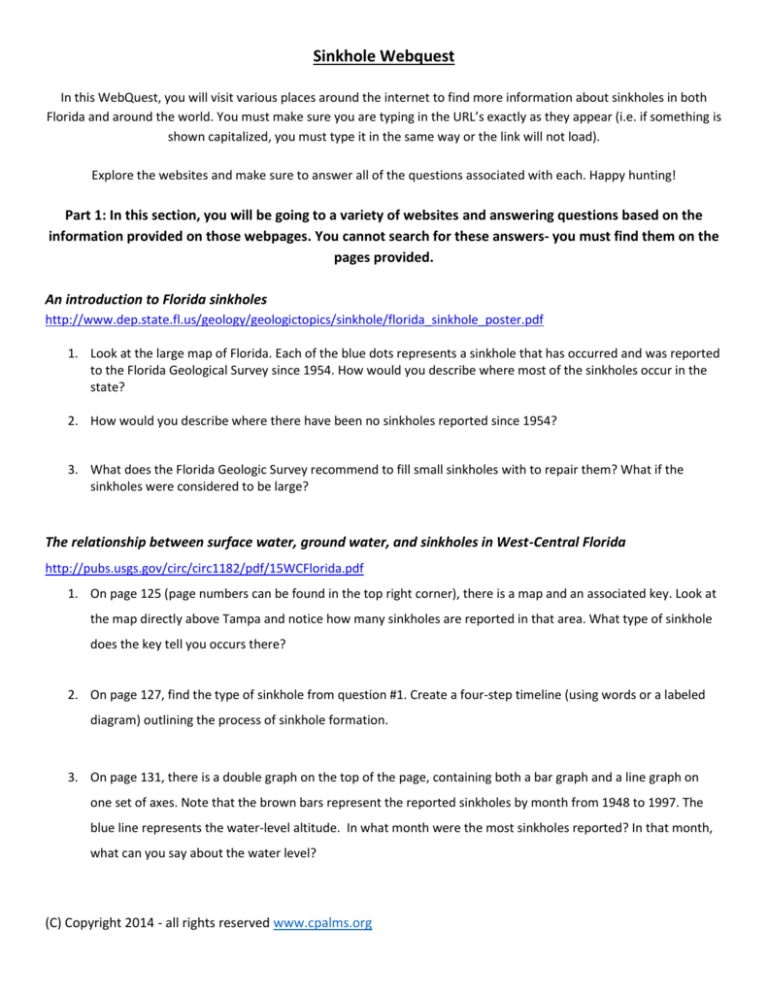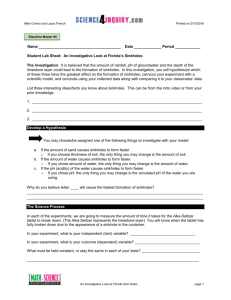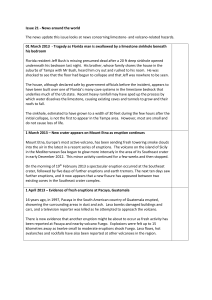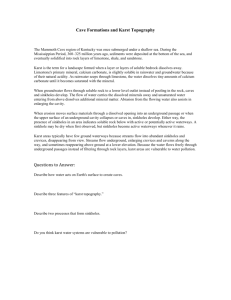
Sinkhole Webquest
In this WebQuest, you will visit various places around the internet to find more information about sinkholes in both
Florida and around the world. You must make sure you are typing in the URL’s exactly as they appear (i.e. if something is
shown capitalized, you must type it in the same way or the link will not load).
Explore the websites and make sure to answer all of the questions associated with each. Happy hunting!
Part 1: In this section, you will be going to a variety of websites and answering questions based on the
information provided on those webpages. You cannot search for these answers- you must find them on the
pages provided.
An introduction to Florida sinkholes
http://www.dep.state.fl.us/geology/geologictopics/sinkhole/florida_sinkhole_poster.pdf
1. Look at the large map of Florida. Each of the blue dots represents a sinkhole that has occurred and was reported
to the Florida Geological Survey since 1954. How would you describe where most of the sinkholes occur in the
state?
2. How would you describe where there have been no sinkholes reported since 1954?
3. What does the Florida Geologic Survey recommend to fill small sinkholes with to repair them? What if the
sinkholes were considered to be large?
The relationship between surface water, ground water, and sinkholes in West-Central Florida
http://pubs.usgs.gov/circ/circ1182/pdf/15WCFlorida.pdf
1. On page 125 (page numbers can be found in the top right corner), there is a map and an associated key. Look at
the map directly above Tampa and notice how many sinkholes are reported in that area. What type of sinkhole
does the key tell you occurs there?
2. On page 127, find the type of sinkhole from question #1. Create a four-step timeline (using words or a labeled
diagram) outlining the process of sinkhole formation.
3. On page 131, there is a double graph on the top of the page, containing both a bar graph and a line graph on
one set of axes. Note that the brown bars represent the reported sinkholes by month from 1948 to 1997. The
blue line represents the water-level altitude. In what month were the most sinkholes reported? In that month,
what can you say about the water level?
(C) Copyright 2014 - all rights reserved www.cpalms.org
Part 2- In this section, you will be using Google Maps (in Earth view) to see satellite photographs of
sinkholes both in Florida and around the world. You will be given coordinates that you will type into Google
Maps (make sure you are on “Earth” view), but you will have to search the internet for the rest of the
information.
Sinkhole in Florida
1. The Winter Park Sinkhole can be found at the coordinates 28.594116, -81.361775, on the corner of Denning and
Fairbanks avenues in Winter Garden.
a. When did the sinkhole occur?
b. What was the size of the sinkhole at its largest?
c. What did scientists determine to be the cause of this sinkhole?
d. What is the origin of the name Lake Rose, the lake that now stands where the sinkhole was?
International Sinkholes
1. The 2010 Guatamala City Sinkhole can be found at the coordinates 14.652065, -90.505881, and Google labels it
at “2010 Sinkhole.”
a. What evidence can you see at this location that a sinkhole occurred here?
b. List three factors that contributed to this sinkhole forming.
c. What were the dimensions of this sinkhole, and how large was the building that collapsed into it?
d. Officials were originally planning to fill the hole with “lodocreto” but decided to use a different
technique. What was it?
2. The Belize Great Blue Hole is located in Lighthouse Reef and can be found at the coordinates 17.308277, 87.534514. When you input the coordinates, you may have to zoom in quite a bit (look for the dark blue spot).
a. We normally think about land-based sinkholes, but this one is located underwater. Explain how the
Great Blue Hole formed.
b. Find at least two more oceanic sinkholes, and tell me their name and location in the world.
(C) Copyright 2014 - all rights reserved www.cpalms.org
Sinkhole Webquest- Answer Key
An introduction to Florida sinkholes
http://www.dep.state.fl.us/geology/geologictopics/sinkhole/florida_sinkhole_poster.pdf
1. Look at the large map of Florida. Each of the blue dots represents a sinkhole that has occurred and was
reported to the Florida Geological Survey since 1954. How would you describe where most of the sinkholes
occur in the state? Central to North Florida
2. How would you describe where there have been no sinkholes reported since 1954? Southern Florida;
students may also say the Panhandle
3. What does the Florida Geologic Survey recommend to fill small sinkholes with to repair them? What if the
sinkholes were considered to be large? Very small holes in yards are commonly filled with natural earth
materials such as rock and clayey sand. Large sinkholes may require the expertise of a professional geologist
or a geotechnical engineering firm with a professional geologist on hand.
The relationship between surface water, ground water, and sinkholes in West-Central Florida
http://pubs.usgs.gov/circ/circ1182/pdf/15WCFlorida.pdf
1. On page 125 (page numbers can be found in the top right corner), there is a map and an associated key.
Look at the map directly above Tampa and notice how many sinkholes are reported in that area. What type
of sinkhole does the key tell you occurs there? Cover-collapse—occur abruptly
2. On page 127, find the type of sinkhole from question #1. Create a four-step timeline (using words or a
labeled diagram) outlining the process of sinkhole formation. Using words: 1. Sediments spill into a cavity. 2.
As spalling continues, the cohesive covering sediments form a structural arch. 3. The cavity migrates upward
by progressive roof collapse. 4. The cavity eventually breaches the ground surface, creating sudden and
dramatic sinkholes. Using pictures: see the diagram on the page.
3. On page 131, there is a double graph on the top of the page, containing both a bar graph and a line graph on
one set of axes. Note that the brown bars represent the reported sinkholes by month from 1948 to 1997.
The blue line represents the water-level altitude. In what month were the most sinkholes reported? In that
month, what can you say about the water level? Most reported- May. The water level has been decreasing
since January, and although the water level is low, the lowest is between May and June.
(C) Copyright 2014 - all rights reserved www.cpalms.org
Sinkhole in Florida
1. The Winter Park Sinkhole can be found at the coordinates 28.594116, -81.361775, on the corner of Denning and
Fairbanks avenues in Winter Garden.
a. When did the sinkhole occur? May 8, 1981.
b. What was the size of the sinkhole at its largest? 320 feet wide, 90 feet deep
c. What did scientists determine to be the cause of this sinkhole? In May 1981, there was a record low
water level in Florida’s limestone aquifer.
d. What is the origin of the name Lake Rose, the lake that now stands where the sinkhole was? The
sinkhole opened up near the house of Mae Rose Williams.
International Sinkholes
1. The 2010 Guatamala City Sinkhole can be found at the coordinates 14.652065, -90.505881, and Google
labels it at “2010 Sinkhole.” ***Make sure the students look up the 2010 sinkhole, not the 2007 one!
a. What evidence can you see at this location that a sinkhole occurred here? Answers may vary, but
when you look at Google Earth you cannot see a hole, so that would be an incorrect response. An
acceptable observation is that there is a wide intersection there.
b. List three factors that contributed to this sinkhole forming. Tropical Storm Agatha, the Pacaya
Volcano eruption, leakage from sewer pipes, excessive rainfall, volcanic pumice deposits.
c. What were the dimensions of this sinkhole, and how large was the building that collapsed into it?
The sinkhole was 65 feet across and 100 feet deep. A three-story factory fell into it.
d. Officials were originally planning to fill the hole with “lodocreto” but decided to use a different
technique. What was it? Graded-filter technique, in which the sinkhole is filled with successive layers
of boulders, smaller rocks, and gravel.
2. The Belize Great Blue Hole is located in Lighthouse Reef and can be found at the coordinates 17.308277, 87.534514. When you input the coordinates, you may have to zoom in quite a bit (look for the dark blue spot).
a. We normally think about land-based sinkholes, but this one is located underwater. Explain how the
Great Blue Hole formed. When sea levels were much lower, a series of caves formed in that location.
The melting of the last Ice Age flooded the save system, and eventually, the porous limestone ceilings of
the caves could no longer support their own weight and crumbled. This left behind an almost perfectly
round and deep hole.
(C) Copyright 2014 - all rights reserved www.cpalms.org
b. Find at least two more oceanic sinkholes, and tell me their name and location in the world.
Some of the possible answers:
Cave of Swallows, San Luis Potosi, Mexico
Blue Hole, Red Sea
Dean’s Blue Hole, Bahamas
(C) Copyright 2014 - all rights reserved www.cpalms.org











